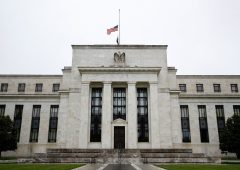US Jobs Report Misses Mark: August Figures Fuel Fed Rate Cut Speculation
06.09.2024 16:10 1 min. read Alexander StefanovIn August, the U.S. job market grew at a slower pace than anticipated, adding 142,000 positions compared to the forecasted 161,000. This figure represents a drop from July’s 89,000 new jobs.
The unemployment rate fell slightly to 4.2%, while the workforce expanded by 120,000, reducing the jobless rate by 0.1 percentage points. However, the labor force participation rate remained unchanged at 62.7%.
An alternative unemployment measure, including those not actively seeking work, rose to 7.9%, its highest since late 2021.
Markets had a muted reaction to the report, with stock futures and Treasury yields showing little movement. Notably, job figures for the previous two months were revised downward, with July’s numbers reduced by 25,000 and June’s by 61,000.
Construction led job gains with 34,000 new positions, followed by healthcare at 31,000 and social assistance at 13,000. Manufacturing, however, lost 24,000 jobs.
Wages increased by 0.4% from the previous month and 3.8% year-over-year, surpassing estimates. Average work hours also ticked up to 34.3.
This data comes as the Federal Reserve prepares for its September 17-18 meeting, with markets expecting a potential rate cut, though the extent remains uncertain.
-
1
Gold Beats U.S. Stock Market Over 25 Years, Even With Dividends Included
13.07.2025 15:00 1 min. read -
2
US Inflation Heats Up in June, Fueling Uncertainty Around Fed Cuts
15.07.2025 16:15 2 min. read -
3
U.S. Announces Sweeping New Tariffs on 30+ Countries
12.07.2025 16:30 2 min. read -
4
Robert Kiyosaki Predicts When The Price of Silver Will Explode
28.06.2025 16:30 2 min. read -
5
Trump Targets Powell as Fed Holds Rates: Who Could Replace Him?
27.06.2025 9:00 2 min. read
US Inflation Heats Up in June, Fueling Uncertainty Around Fed Cuts
U.S. inflation accelerated in June, dealing a potential setback to expectations of imminent Federal Reserve rate cuts.
Gold Beats U.S. Stock Market Over 25 Years, Even With Dividends Included
In a surprising long-term performance shift, gold has officially outpaced the U.S. stock market over the past 25 years—dividends included.
U.S. Announces Sweeping New Tariffs on 30+ Countries
The United States has rolled out a broad set of new import tariffs this week, targeting over 30 countries and economic blocs in a sharp escalation of its trade protection measures, according to list from WatcherGuru.
Key U.S. Economic Events to Watch Next Week
After a week of record-setting gains in U.S. markets, investors are shifting focus to a quieter yet crucial stretch of macroeconomic developments.
-
1
Gold Beats U.S. Stock Market Over 25 Years, Even With Dividends Included
13.07.2025 15:00 1 min. read -
2
US Inflation Heats Up in June, Fueling Uncertainty Around Fed Cuts
15.07.2025 16:15 2 min. read -
3
U.S. Announces Sweeping New Tariffs on 30+ Countries
12.07.2025 16:30 2 min. read -
4
Robert Kiyosaki Predicts When The Price of Silver Will Explode
28.06.2025 16:30 2 min. read -
5
Trump Targets Powell as Fed Holds Rates: Who Could Replace Him?
27.06.2025 9:00 2 min. read


